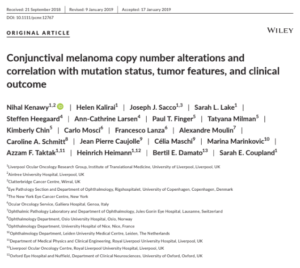Eye Cancer Care in Ethiopia
The Eye Cancer Foundation’s “2020 Campaign” claims another country, Ethiopia! We supported intensive training of a local ophthalmologist on advancements in retinoblastoma research, treatment, and diagnosis. Our most recent ECF grant recipient, Dr. Abu Amare, an ophthalmologist in Ethiopia, just completed a 6-month retinoblastoma fellowship at the Rasoole-E-Akram Hospital of The Iranian University of Medical Sciences in Tehran, Iran.
Dr. Amare notes of his experience, “The fellowship program made a big difference in my skill and knowledge in diagnosing retinoblastoma…” He also is grateful for the opportunity to have been able to shadow physicians in different disciplines, such as oculoplastic surgery, learning about enucleation and evisceration — he also observed interventional neuroradiology for intra-arterial chemotherapy and surgeons performing plaque radiotherapy. Dr. Amare was able to connect with his mentors, as they were polite and courteous and took their time to truly teach him techniques, such as RetCam photography, that he called “profound to the maximum” and with “no limitations.” Further, he was exposed to ophthalmic pathology, including tissue processing and examinations under light microscopy for a variety of eye tumors. These valuable skills for an ophthalmologist specializing in retinoblastoma are necessary for its early diagnosis and treatment.
With the help of the ECF, Ethiopia has gained a learned and more knowledgeable ophthalmologist who can help in preventing blindness and retinoblastoma-metastasis within the Ethiopian population. The Foundation has given Dr. Amare the tools necessary to organize the first ever eye cancer center in his home country. On his plan to share what he has learned as a fellow, Dr. Amare says that he would “start with organizing the appropriate instruments and equipment to establish a dedicated team…creation of awareness [about retinoblastoma] ranges from policy makers down to different levels, specialties, and supports.” Such comprehensive training through the fellowship program that the ECF provides will save the sight and lives of thousands of people, for generations to come.
We will continue to focus on unserved and underserved countries with little to no eye cancer care. The Eye Cancer Foundation will continue to help Dr. Amare organize his ambitious and driven team, and plans to prevent and cure retinoblastoma in Ethiopia.
For more information on The Eye Cancer Foundation and its mission, visit www.eyecancercure.com.
To donate and help sponsor more specialty training in unserved and underserved countries, go to www.eyecancercure.com/donate.


 With access to a large sample of nearly 100 patients from eight different eye cancer centers around the world, the researchers behind this study sought to clearly define key
With access to a large sample of nearly 100 patients from eight different eye cancer centers around the world, the researchers behind this study sought to clearly define key  Click here for the full-text!
Click here for the full-text!







